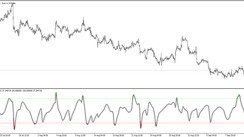In the financial markets, dominance refers to the degree to which one asset or asset class dominates the market. Bullish dominance occurs when the price of an asset is rising and investors are generally optimistic about its future prospects. Bearish dominance occurs when the price of an asset is falling and investors are generally pessimistic about its future prospects.
How to Identify Bullish and Bearish Dominance
There are a number of ways to identify bullish and bearish dominance. One way is to look at the price chart of the asset. If the price is rising in a sustained manner, then this is a sign of bullish dominance. If the price is falling in a sustained manner, then this is a sign of bearish dominance.
Another way to identify bullish and bearish dominance is to look at the relative strength index (RSI). The RSI is a technical indicator that measures the strength of a trend. An RSI above 70 indicates that the asset is overbought and is likely to experience a correction. An RSI below 30 indicates that the asset is oversold and is likely to experience a rebound.
Factors Affecting Bullish and Bearish Dominance
Fundamental factors: These include economic data, company earnings, and political events. For example, if economic data shows that the economy is growing, then this could lead to bullish dominance in the stock market.
Technical factors: These include price charts, moving averages, and indicators such as the RSI. For example, if the price of an asset is breaking out above a key resistance level, then this could lead to bullish dominance.
Sentiment: This refers to the overall mood of the market. If investors are generally optimistic about the future, then this could lead to bullish dominance.
If investors are generally pessimistic about the future, then this could lead to bearish dominance.
Experts' Opinions on Bullish and Bearish Dominance
There are a number of experts who believe that bullish and bearish dominance can be useful tools for traders. One such expert is Mark Douglas, author of the book "Trading in the Zone." Douglas argues that bullish and bearish dominance can help traders to identify the overall trend of the market and to make better trading decisions.
Another expert who is a proponent of bullish and bearish dominance is Van Tharp, author of the book "Trade Your Way to Financial Freedom." Tharp argues that bullish and bearish dominance can help traders to stay disciplined and avoid making emotional decisions.
Tips for using bullish and bearish dominance:
Use multiple timeframes. This will help you to identify the trend in different time-frames and to avoid getting caught in a false breakout. Use other technical indicators. This will help you to confirm the trend and to identify potential entry and exit points. Be patient. Don't expect to get rich quickly. Bullish and bearish dominance can take time to develop.
If you are looking for a way to improve your trading, then learning about bullish and bearish dominance is a good place to start. By understanding these concepts, you can make better trading decisions and increase your chances of success.
Conclusion
Bullish and bearish dominance are important concepts for traders to understand. By understanding these concepts, traders can identify the overall trend of the market and make better trading decisions.





